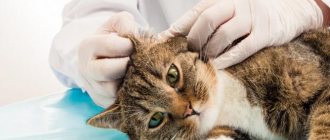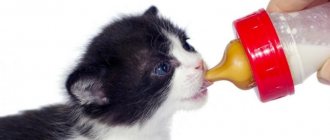Ctenocephalidosis (or flea infestation) is the most common disease among domestic and stray cats. Insects not only cause discomfort to animals, but are also carriers of infectious diseases and intestinal parasites.
To prevent the development of serious illnesses, you need to regularly treat your pet. Let's find out what signs indicate the presence of fleas in a cat.
Difficulties in diagnosing flea infestations
Cats are very clean animals; they are capable of licking their fur for 4-5 hours a day. Due to such active hygiene, pets are able to independently catch biting parasites in their fur, lick and swallow their excrement. In addition, fleas do not live permanently on the animal’s body, but only feed on blood. The rest of the time, fleas “travel” around the apartment. Favorite places for their localization and reproduction are carpets, baseboards, and cracks in the floor.
It is these two facts that make it difficult to visually diagnose the presence of parasites on an animal’s body. You can independently determine that a cat has fleas if the animal is not aggressive and is handled.
The methods described below will help with this. But to find fleas in an aggressive cat, it is better to go to a veterinary clinic, where a specialist will securely restrain the animal, examine and treat it.
How dangerous are fleas for cats and humans?
It has been known since ancient times that cat fleas can be carriers of a number of diseases that are most dangerous to humans. The greatest threat to life and health is posed by individuals that parasitize rats. It is they who are capable of infecting a person with such terrible diseases as typhus and plague, which was observed in the Middle Ages.
A cat infected with fleas suffers from sharply deteriorated mental and physical well-being. Quite often, parasite bites provoke allergic reactions and dermatitis. In addition, these insects carry worms. Ectoparasites are carriers of a dangerous disease for cats - hemobartonellosis. This disease leads to a sharp decrease in the content of red blood cells in the blood, which provokes the development of anemia. Fleas are the source of a number of fungal and viral diseases that affect internal organs and cause fever.
With a particularly complex clinical picture of infection, the animal suffers mentally and can almost completely and irrevocably lose its fur.
Detection of parasites on an animal
The easiest way to understand that a cat has fleas is to carefully examine its fur for the presence of small insects running and jumping. To do this, the cat needs to be seated on the owner's lap, parted the fur and examined in the area of the chin, neck, spine, abdomen, groin and tail.
The most fleas will be in those places where cats cannot lick themselves.
If the cat is nursing, then you need to inspect each kitten - in babies, fleas are often localized on the head and stomach.
What fleas look like: they are small (2-3 mm) black wingless insects whose body has an oval shape and three pairs of prehensile legs. They are distinguished by incredible jumping ability and speed of movement among the hairs, so it is almost impossible to catch them with your fingers.
Important! Fleas can live without food for several months. That is why, if active insects are detected on a cat, you should definitely treat the entire apartment with effective flea remedies.
How to rid a cat of fleas
Treating your pet for ectoparasites requires patience and an integrated approach. Here are some basic recommendations on how to remove fleas from a cat as effectively as possible:
- First of all, take care of thoroughly processing, cleaning and washing all the cat beds, bedding, and rugs in the house. Be sure to do a general wet cleaning of the house, vacuum all the beds and sofas. This way you will clear your home of flea excrement and eggs. Be sure to throw away the filter bags immediately.
- As soon as you and your pets return home from a walk or trip, you should immediately check their fur for parasites. This rule especially requires compliance in the spring and summer, when fleas are found literally at every step - in the grass, on the ground, in the basements of apartment buildings. For previously infected pets, it is very important to use antiparasitic repellent care products.
- If your pet has already suffered from fleas, do not forget to periodically disinfect the house.
How to remove fleas from a cat using shampoos and sprays?
Today there are many specialized products on the market designed to effectively combat ectoparasites.
Among the most recommended:
| Drops | Anti-flea drops are a product applied to the cat’s withers. Properly selected drops provide almost instant relief from the symptoms of infection and at the same time have a residual effect. Unfortunately, they have a serious drawback: this product causes allergies in many cats. |
| Sprays | An equally effective way to rid an animal of parasites. Flea sprays are often used to quickly treat fleas in cats, but have no residual effect. The advantage of sprays is their hypoallergenicity. |
| Shampoos | One of the safest and most effective methods for ridding cats of insects. To ensure that the effect of their use does not disappoint, carefully read the instructions. It is also worth considering that your pet may react violently to bathing. It is very important to ensure that the shampoo does not get into your cat's eyes. |
| Collar | A flea collar is not a treatment, but is quite effective in preventing infestation. It is still necessary to use a collar, but only as an addition to the treatment methods described above. Pets released outside definitely cannot do without it. |
| Powders | Powders and tablets can be quite effective, but are not so convenient to use. Tablets should be given to a pet only after the animal has been examined by a veterinarian. |
Detection of insect feces
Reliable signs of the presence of fleas (in addition to the detection of live insects) is the presence of their feces. They look like brown-red or black dots located on the skin at the base of the hairs. When crushed between the fingers, the feces crumble and leave a reddish mark.
With a small number of insects, black spots are most often localized in a cat in the abdomen, spine and at the base of the tail.
Intradermal allergy test for flea saliva
The third type of research should be carried out in laboratory conditions. Before prescribing an intradermal allergy test for flea saliva, the veterinarian will conduct a general clinical examination of the cat and collect an anamnesis. A specific study may be necessary if the cat has developed flea dermatitis, which is an allergic reaction to the saliva of blood-sucking insects, but there are no fleas themselves.
In a clinical setting, the doctor gives the cat an allegotest. To do this, allergens are administered subcutaneously to determine the body's sensitivity to certain substances. Based on the data obtained, the specialist develops treatment tactics.
Wet paper test
If the cat has a dark color or very thick fur, then visual diagnosis of the presence of ectoparasites will be difficult. There is a simple and proven method with wet paper. With its help, you can check the fur quickly and without stress for the animal.
To do this, you will need to spread sheets of white paper on the floor (you can use pieces of old wallpaper) and place a cat in the center. Next, caress the pet, pet it, comb it, fluff the fur a little to shake out any debris and dust particles. Particular attention should be paid to cleaning the fur in the area of the belly, tail and muzzle.
Then you need to carefully examine the surface of the paper. If black dots are found, they are sprayed with water from a spray bottle.
If the result is positive, black dots on damp paper will be blurred by a dark burgundy (brown) halo. This is flea feces. Since insects feed on blood, it is present in their excrement and, under the influence of water, colors the white sheet. The more dark stains there are, the more fleas there are.
Preventative care for long-haired cats
Fleas love to live in warm, enclosed spaces. Therefore, a thick undercoat, especially in winter, creates favorable conditions for the rapid reproduction of parasites.
Combing.
Cats need regular brushing.
For this purpose, there are special brushes with a flat working area with attached many thin and tenacious curved metal knitting needles.
Active combing with such an accessory allows you to get rid of excess hair and reduce the risk of flea infestation. Indeed, in the case of contact with parasites, the problem is sometimes discovered completely by accident. Short-haired breeds are less demanding in this regard, but some individuals simply love such procedures due to their nature.
Indoor cleaning and furniture processing. It is also necessary to carry out full cleaning of the living space with increased frequency. Owners of cats of long-haired breeds are familiar firsthand with accumulations of piles of hair in all corners of the apartment, in flower pots, on the upholstery of upholstered furniture, etc. In these cases, it is recommended to clean more often and start with the initial cleaning of all surfaces with a vacuum cleaner.
To remove wool from upholstered furniture, you will need a basin of warm water. With a moistened hand, stuck-on fluff can be easily removed. It is better to throw the collected lumps into the trash; it is not advisable to flush them down the toilet, so as not to cause a sewer blockage.
Also watch the video on how to find out if a cat has fleas:
Presence of cucumber tapeworm segments in feces
Another way to tell if your cat has fleas is to look in the litter box immediately after your pet defecates and examine the fresh feces. In them you can find white moving inclusions of oval shape, similar to Fig. These are segments of the cucumber tapeworm, an intestinal parasite that enters the body of cats through fleas.
A little history of cucumber tapeworm infection
Dipylidiasis is a disease that develops when a cat accidentally swallows an infected flea that contains parasite eggs in its stomach. A flea that enters the gastrointestinal tract is digested, and the tapeworm egg goes through several stages of development in the intestine.
As a result of metamorphosis, the worm grows up to 70 cm in length. Parasitologists call it the cucumber tapeworm.
For 1 year, the helminth lives in the cat’s intestines and constantly excretes parts of its body (segments) filled with a new batch of eggs with feces. It is also possible for the worm's segments to randomly fall out of the cat's anus when the pet is sleeping or sitting in the owner's arms. Subsequently, the eggs end up on animal bedding and are eaten by flea larvae, and the development cycle repeats.
Important! A person can become infected with dipilidia only if they swallow a flea.
Expert opinion
Chepa Natalya Semenovna
Veterinarian
Ask a Question
Among cats, fold-eared breeds are most prone to otitis, because... they have a small closed ear and a narrow ear canal that is poorly ventilated. Hairless breeds produce a lot of sulfur, which can also be a predisposing factor for the development of otitis media. A common mistake owners make when caring for their ears is using a cotton swab. It will not be possible to clean the ear well with a cotton swab due to its structure, but leaving the cotton swab, “compacting” the wax inside the passage and causing irritation of the skin of the ear canal is quite likely. For home care, it is best to use special lotions no more than once a month. You should not use multi-component ear drops on your own. Medications should be prescribed by a doctor based on a cytological examination.
Prevention and treatment
If the owner has discovered that the pet has been attacked by fleas, it is worth immediately taking measures to eliminate the parasites. They are quite prolific. The sooner you start treating an animal, the fewer of them will breed in the future.
- Choose the right product.
Modern drugs are quite effective and safe for animals. They are sold in veterinary pharmacies, most of them are available without a prescription. It is important to choose products specifically for cats, as some drugs for dogs can have a negative effect on the body of other pets. Zoo shampoo "Four with a tail" contains only repellent ingredients and is therefore safe for cats. - Treat your animal regularly.
In this case, follow the instructions for the product and the doctor’s recommendations. This way you can protect your pet from parasites and save him from possible problems in the future. If treatment resolves the unpleasant symptoms, then they were caused by fleas, even if you could not detect them. - Choose a suitable collar.
A repellent collar repels parasites and makes the animal's odor unattractive to them. The product is a porous tape with an applied active substance. For example, the repellent collar “Four with a tail” contains essential oils and is used to protect against lice, fleas, mosquitoes, lice, scabies and ixodid ticks. A repellent collar can help prevent fleas from reinfecting your pet. - Protect your home from fleas.
Eggs and pupae of parasites can remain alive for up to several months. Therefore, treat your home with special products intended for indoor use. Vacuum upholstered furniture and carpets daily. If the infestation is severe, consider calling a pest control service.
Characteristic symptoms
As the disease progresses and insects spread throughout the house, the following characteristic signs appear:
- The cat has constant itching in different places, which is why it can twitch, jump up sharply, shake its head and vigorously scratch the flea bites.
- Remains of “garbage from blackheads and fur” after the cat sleeps or on the owner’s clothes. Observed when there is a high degree of flea infestation in a pet.
- Deterioration in the quality of the animal's fur (dullness, fragility, bald spots).
- Jumping fleas on carpets and furniture in the house (parasites are especially noticeable on light-colored things).
- The appearance of bites in children and other family members (on the legs and arms).
- Infection of other pets.
The appearance and intensity of development of the listed symptoms will depend on the size of the flea population in the room. If you do not provide help to the cat and without carrying out pest control measures, the symptoms will only increase.
Itching, scratching
This is the first characteristic symptom by which you can quickly find out whether your cat has fleas or other ectoparasites. In healthy animals, the ritual of hygiene of the coat and body includes licking, occasional scratching, and biting their claws to cleanse them of dirt. And a flea-ridden pet carries out all these procedures with intense scratching and biting.
As a result, the fur begins to fall out in clumps. Bald spots appear on the body (especially at the base of the tail), and bald spots on the face (under the ears) increase.
Due to constant itching and scratching on the cat’s body, non-healing wounds from claws appear, which the animal additionally licks and scratches. All this further complicates the healing process.
Anemia of kittens
Anemia is a disease of the circulatory system that is described as a decrease in blood volume in the body or a decrease in the number of red blood cells and hemoglobin. Anemia develops as a consequence of some pathological condition in the animal’s body (in this case, flea infestation).
There is a theory that one flea per day is capable of drinking 1 drop of blood, and if the number of individuals is in the dozens, and everyone feeds on a weakened young body, then the likelihood of developing anemia in kittens becomes very high. If treatment is not carried out, the animal will become weak and may die.
Symptoms of anemia development:
- pale mucous membranes (the almost white color of the mucous membrane in the kitten’s mouth is indicative);
- weakness and low mobility;
- loss of appetite or complete refusal to feed;
- dyspnea.
Unfortunately, among newborn kittens with massive flea infestation, the percentage of deaths from acquired anemia is high.
Flea allergic dermatitis
Some cats are highly sensitive to flea bites and their saliva. This reaction is expressed by focal or extensive alopecia (baldness), scaly skin and inflammatory processes.
The clinical picture may be aggravated by the appearance of swelling, redness and severe itching at the bite sites. The cat becomes nervous, sleeps and eats poorly, expresses anxiety with frequent meows and constantly itches.
The wounds bleed, which further attracts fleas. Veterinarians call this pathology allergic flea dermatitis.
Treatment of insect bites
Many children (and some adults) have pronounced local reactions to the bites of midges (mosquitoes, midges, horseflies): immediately after the bite, a urticarial element forms around it within a radius of 1–3 cm (as in urticaria, intradermal edema), lasts for several hours and itches intensely. Then it turns into a papule, which is smaller in size but more persistent. On top of this papule there are often scratches and bloody or serous crusts. The papule usually goes away within a few days, but the crusts can remain for a very long time - if a person scratches them with his nails several times a day, rips them off, and they form again. The use of external or systemic medications after insect bites reduces the likelihood of serious scratching, secondary infection, reduces unpleasant symptoms (itching, swelling at the bite site, burning and hyperemia) and speeds up recovery. This is especially important for children, who are prone to more violent local reactions and are much less able to restrain the urge to scratch the bite site until a bloody scab appears.
Immediately after the bite
As soon as you find urticarial marks on your child’s skin from fresh bites (you came home from the street or picked up a woken up baby in your arms), apply a cooling antipruritic mash (Calamin or Tsindol) to the bite sites. Repeat application once an hour on this day, most likely in a day you will hardly be able to find the bite site (all changes on the skin will disappear).
If the urticarial element nevertheless turns into a papule or crust
If you did not apply the mash, or did, but a papule still forms and itches, start applying a low-potency steroid cream (hydrocortisone eye ointment, Sinaflan or Afloderm) to the area. The steroid is applied 1–2 times a day; a volume of ointment of no more than half a grain of rice is required for one element of the rash. The course usually takes 2–4 days, during which time the element will almost completely disappear. For severe itching or local swelling, you can use a second-generation antihistamine, such as Zodak (as directed) for several days in a row.
If a midge has bitten near the eye or on the lip, and swelling of frightening proportions has developed
In this case, the child’s eyes may stop opening, and problems with pronouncing words may appear (a swollen lip makes it difficult to speak clearly). Most often, it is enough to just wait, or apply cold and wait - and after 15-30 minutes such local swelling begins to subside, and after an hour it disappears completely. In severe cases, or if you want to speed up recovery, you can (in addition to cold) use an antihistamine internally and a local steroid externally.
If bitten by a Hymenoptera (wasp, bee, bumblebee, hornet, etc.)
The bite or sting of Hymenoptera is much more unpleasant and dangerous than the bites of ordinary midges. They cause severe pain, a strong local reaction (redness, itching, swelling) and take much longer to resolve. With multiple bites, in addition to local reactions, there may be severe systemic reactions (malaise, fever, weakness, loss of appetite), which disappear within a few days. Additionally, some people are allergic to Hymenoptera venom and may develop anaphylactic reactions and even die from such stings. Help for single bites in the absence of anaphylaxis (fainting or semi-fainting, a pronounced change in general well-being) is generally no different from help for a midge bite, but the effect will have to wait much longer. If severe systemic reactions occur, you must immediately consult a doctor, and if anaphylaxis and/or Quincke's edema occurs in the larynx (hoarseness and severe difficulty breathing), call an ambulance immediately. For a person who has experienced anaphylaxis at least once in their life, the doctor will write a prescription for epinephrine (ideally an epinephrine pen) and teach him and his loved ones how to use this drug while waiting for an ambulance.
Important: when stung by a bee, you need to remove the sting from the wound as quickly as possible; assistance begins with this step.
A common complication of insect bites: papular urticaria
Papular urticaria is a rash that occurs in response to insect bites in places where the insect has not bitten; this is a “slow allergy” to bites. Most often it occurs in response to bites from fleas (including fleas), ticks and scabies, but a simple gnat can also lead to it. Papular urticaria is not dangerous, but can be uncomfortable, itchy, cosmetically unsightly and last for several months. It will go away on its own sooner or later, but a long course of antihistamines and sometimes local treatment can be useful to relieve symptoms and speed up recovery. You can read more here.
General Tips
Try not to let your child scratch the bite area, especially the eyes. This gives immediate relief, but leads to scratching, infection, and significantly lengthens the recovery time.
Author:
Butriy Sergey Alexandrovich pediatrician











